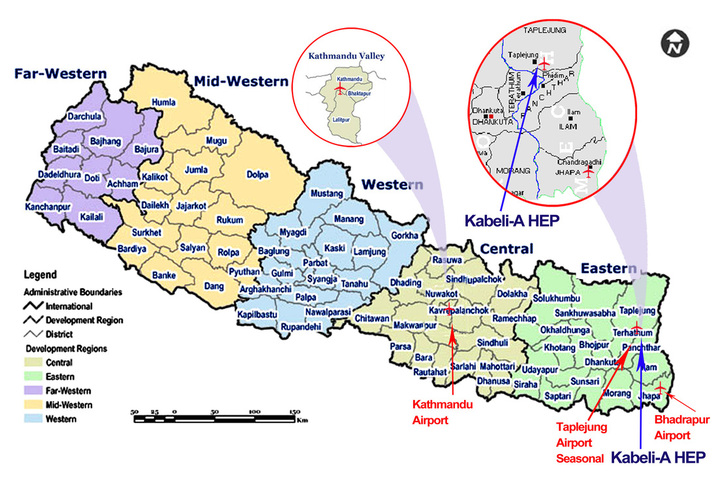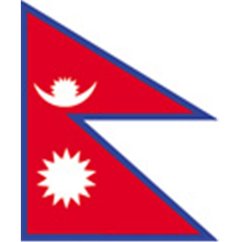Canadian Site Portal
Get Started
Introduction to Nepal
The country of Nepal is located in South Asia bordering the People's republic of China to the north and the Republic of India to the south, east and west . Nepal lies in the Himalayan mountain range and boasts the highest elevations in the world. This includes Mt. Everest. with a height of 8848 meters. This landlocked nation has a population of about 27 million, classifying it as the world's 41st most populous country. Nepal has an area of 147,181 square kilometers. Due to a dramatic range in elevation, the climate regions and topography of Nepal vary greatly. Nepal is divided into five general climate zones which are dependent upon the altitude of the region. These zones include: tropical & subtropical zone (below 1200 m), temperate zone (1200 m- 2400 m) , cold zone (2400 m -3600 m), subarctic zone (3600 m- 4400 m) and Arctic zone (above 4400 m).
Nepal is also divided into three main geographical regions including the lowland plains (Terai), the hill region (Pahad) and the mountain region (Parbat). These regions run in the east-west direction and are intersected by river systems flowing from north to south. The Terai lowlands are comprised of tropical savannas, grasslands, valleys and foothills. Bordering India, this region is classified as a tropical to sub-tropical climate with elevation levels only reaching 1000 meters. Due to this climate the Terai lowlands are fertile and humid. The hill region (Pahad) has a more mountainous geography, containing mountain ranges of 800 m in elevation up to 4000 meters. Sub-tropical river valleys occupy the southern end of the hill region while alpine climates distinguish the northern end with occasional snowfall in the winter. Population density is highest in the hill region of Nepal. Northern Nepal is made up of the mountain region, also containing the Himalayan mountain range. This region is known for is subarctic and arctic climates.
The country of Nepal is located in South Asia bordering the People's republic of China to the north and the Republic of India to the south, east and west . Nepal lies in the Himalayan mountain range and boasts the highest elevations in the world. This includes Mt. Everest. with a height of 8848 meters. This landlocked nation has a population of about 27 million, classifying it as the world's 41st most populous country. Nepal has an area of 147,181 square kilometers. Due to a dramatic range in elevation, the climate regions and topography of Nepal vary greatly. Nepal is divided into five general climate zones which are dependent upon the altitude of the region. These zones include: tropical & subtropical zone (below 1200 m), temperate zone (1200 m- 2400 m) , cold zone (2400 m -3600 m), subarctic zone (3600 m- 4400 m) and Arctic zone (above 4400 m).
Nepal is also divided into three main geographical regions including the lowland plains (Terai), the hill region (Pahad) and the mountain region (Parbat). These regions run in the east-west direction and are intersected by river systems flowing from north to south. The Terai lowlands are comprised of tropical savannas, grasslands, valleys and foothills. Bordering India, this region is classified as a tropical to sub-tropical climate with elevation levels only reaching 1000 meters. Due to this climate the Terai lowlands are fertile and humid. The hill region (Pahad) has a more mountainous geography, containing mountain ranges of 800 m in elevation up to 4000 meters. Sub-tropical river valleys occupy the southern end of the hill region while alpine climates distinguish the northern end with occasional snowfall in the winter. Population density is highest in the hill region of Nepal. Northern Nepal is made up of the mountain region, also containing the Himalayan mountain range. This region is known for is subarctic and arctic climates.
Agriculture in Nepal (under construction)
Agriculture in Nepal is dictated by altitude. Nepal can be divided into 3 major agricultural zones that run east-west: the southern most strip, or terai, is the flattest. The middle zone is the midhills, while the most northern zone is the mountainous region.
Agriculture in Nepal is dictated by altitude. Nepal can be divided into 3 major agricultural zones that run east-west: the southern most strip, or terai, is the flattest. The middle zone is the midhills, while the most northern zone is the mountainous region.
Nepal's Political Structure/Organization
The government of Nepal functions as a federal republic with a political system of multiple parties. There are three main sectors of government including an executive branch, legislative branch and a judiciary branch. The country is also subdivided into five developmental regions, which act as administrative regions. Each developmental region is then broken into smaller areas known as zones. Nepal has 14 zones which are comprised of 75 smaller districts. Every district is headed by an elected Chief District Officer (CDO). Districts are made up of multiple Village Development Committees (VCD). There are 3915 VCDs throughout the country of Nepal. A VCD is composed of nine smaller political divisions known as wards. Each ward encompasses municipal or metropolitan areas within the country.
The government of Nepal functions as a federal republic with a political system of multiple parties. There are three main sectors of government including an executive branch, legislative branch and a judiciary branch. The country is also subdivided into five developmental regions, which act as administrative regions. Each developmental region is then broken into smaller areas known as zones. Nepal has 14 zones which are comprised of 75 smaller districts. Every district is headed by an elected Chief District Officer (CDO). Districts are made up of multiple Village Development Committees (VCD). There are 3915 VCDs throughout the country of Nepal. A VCD is composed of nine smaller political divisions known as wards. Each ward encompasses municipal or metropolitan areas within the country.
What to Learn More?
Here are some selected links that can provide more details and information about the country of Nepal. Topics are outlined below.
General Info on Nepal: Export Development Canada (EDC)
Living/ Travelling in Nepal: Government of Canada
Tax system in Nepal: Inland Revenue Department
Overview of Nepal: Food and Agriculture Organization of the United Nations
General Introduction: Government of Nepal, Ministry of Agricultural Development Agribusiness Promotion and Marketing Development
Country Profile of Nepal: The World Bank
Canada-Nepal Relations: Canada Foundation for Nepal
Here are some selected links that can provide more details and information about the country of Nepal. Topics are outlined below.
General Info on Nepal: Export Development Canada (EDC)
Living/ Travelling in Nepal: Government of Canada
Tax system in Nepal: Inland Revenue Department
Overview of Nepal: Food and Agriculture Organization of the United Nations
General Introduction: Government of Nepal, Ministry of Agricultural Development Agribusiness Promotion and Marketing Development
Country Profile of Nepal: The World Bank
Canada-Nepal Relations: Canada Foundation for Nepal

